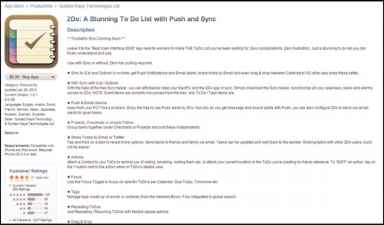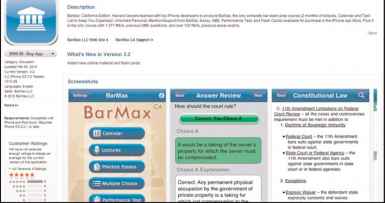Selling Value
Because you can't have a conversation with your buyer about the price of your app, you may be wondering how you convince someone that the value of your app is worth the asking price. This is really the crux of the issue. Buyers must think that they are getting what they pay for in terms of quality, usefulness, and return on their investment. If you can convince your buyer of at least one of these three points, you are more likely to achieve the sale. You have to let your app, App Store verbiage, product website, and reputation do the talking.
WKifi New In VarMon 1,?
+fiwtt OS 31 CvTam
WKifi New In VarMon 1,?
+fiwtt OS 31 CvTam klHIHllDtl klHIHllDtl

- Figure 12.2 A higher priced app is generally focused on a narrow audience such as pilots who own an iPhone/iPad.
Selling Quality
One area of iPhone/iPad apps that has done a great job of selling quality is mobile navigation. Mobile GPS apps have really become popular over the past year, and the quality has approached that of regular auto GPS systems. Still, buyers want to be sure they are buying quality when spending $50-$100 on an iPhone/iPad app. The graphics and accuracy of the GPS have to be of the highest quality. As you can see in Figure 12.3, pricing for navigation apps is between $50 and $100 from a number of competing companies. And, yes, there are a few free and $0.99 apps in this category but not of the caliber found in the higher price range.
All Apps Tar "mobile navigator"
rrt Q3
|
API ™5S™ |
fcy =r™ |
EE | ||||||||||||||
|
GEj ■ |
ran | |||||||||||||||
|
5E) |
GE) | |||||||||||||||
|
.HMhiMW |
^^^ MM |
^IfflH Figure 12.3 Mobile Navigation apps sell on quality and accuracy of their systems keeping their prices far above the regular iPhone/iPad app price. You can also help buyers of this app understand that their iPhone/iPad can function as a turn-by-turn navigation system when they need it without having to go buy a completely separate navigation system for their car. Anytime your app allows the iPhone/iPad to function as another device, the customer is actually saving money by not buying the other device. Be sure to point this out to your buyer, and immediately they will not be as hesitant about the price because you are extending the value of their mobile device. Many thought that after Google offered its free turn-by-turn navigation app that prices would continue to sink lower for navigation apps. While it's true companies like Garmin (TomTom) have had to drop prices dramatically for their apps, the prices for high-end navigation apps had remained constant at the time of this writing. Anytime you can provide an app that saves people time in their business or dealing with their clients, you have an opportunity to sell your app a higher price. You can focus your app verbiage on how your app saves consumers time and makes them more efficient. The more efficient people are, the more clients they can see daily, and the more they can offer in terms of better service. Your app customer views this as a valuable tool if your app can provide this capability. There are a number of productivity apps on the App Store, and some are geared to very specific audiences such as doctors, lawyers, financial advisors, dentists, and so on. Figure 12.4, for example, is an app geared to physicians that allows them to track their patients. Physicians can wirelessly write prescriptions and patient info to other databases at their office. Other apps that fall into the usefulness category include calendaring and organization apps. To charge a higher price than free or $0.99, your app must provide connectivity to other systems or provide a level of functionality not typically found in the less expensive apps. Figure 12.5 shows an example of an app that uploads updates to iCal and Outlook. The most expensive app on the App Store is called BarMax CA, which is currently listed for $999.99. Yes, a thousand dollars will get you all the materials you need to prepare for the California bar exam. The company justifies its price because it typically offers the same material in a classroom setting for $3,000-$4,000. The Selling Usefulness Selling Return on Investment u
Figure 12.4 iChart EMR sells for $139.99 and allows physicians to track patients and the health histories, write prescriptions, and transmit data to their main database.
difference, of course, is that you don't get a live instructor on the iPhone/iPad. The app includes thousands of pages of prep materials and hours of audio lectures. The course takes about two months and consists of multiple choices, essays, and performance exams. And this can all be done from your iPhone/iPad. An example of this application is shown in Figure 12.6. If your app sells for more than $10, you can look for ways to communicate to your buyer that your app can save them money. One way to do this is through a case study on your product website or App Store verbiage where you explain an actual use case for your app, particularly how someone saved money by using your app. Through a case study, you should be able to demonstrate to your reader how your app saved people money and how long it took them to save X dollars. When reading such an illustration, your buyers will take comfort in knowing that they will make up their investment in your app with just a few uses. This approach to selling takes away the risk for the buyer to some degree. BarMai CA BarMai CA
| ||||||||||||||
Continue reading here: Cross Selling and UpSelling
Was this article helpful?

